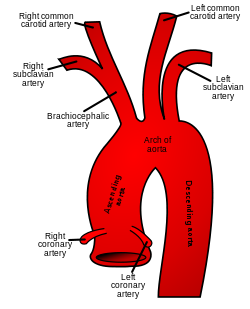Descending aorta
| Descending aorta | |
|---|---|

Plan of the branches.
|
|

The thoracic aorta, viewed from the left side.
|
|
| Details | |
| Precursor | Dorsal aorta |
| Source | Ascending aorta |
| Branches | Abdominal aorta |
| Identifiers | |
| Latin | Aorta descendens, pars descendens aortae |
| MeSH | A07.231.114.056.372 |
| Dorlands /Elsevier |
p_07/12616698 |
| TA | A12.2.10.001 |
| FMA | 3784 |
|
Anatomical terminology []
|
|
The descending aorta is part of the aorta, the largest artery in the body. The descending aorta is the part of the aorta beginning at the aortic arch that runs down through the chest and abdomen. The descending aorta anatomically consists of two portions or segments, the thoracic and the abdominal aorta, in correspondence with the two great cavities of the trunk in which it is situated. Within the abdomen, the descending aorta branches into the two common iliac arteries which serve the pelvis and eventually legs.
The ligamentum arteriosum connects to the junction between the aortic arch and the descending aorta in foetal life. This artery later regresses as the ductus arteriosus.
This article incorporates text in the public domain from the 20th edition of Gray's Anatomy (1918)
...
Wikipedia
